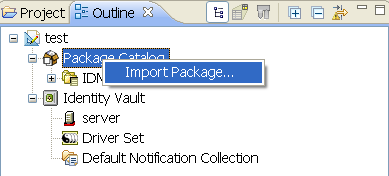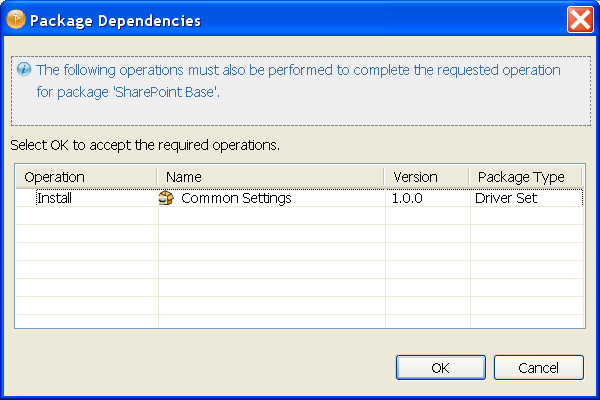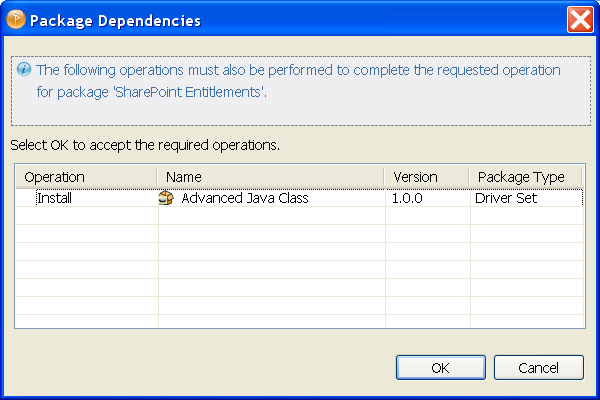3.1 Creating the Driver in Designer
You create the SharePoint driver by installing the driver packages and then modifying the configuration to suit your environment. After you create and configure the driver, you need to deploy it to the Identity Vault and start it.
3.1.1 Importing the Current Driver Packages
The driver packages contain the items required to create a driver, such as policies, entitlements, filters, and Schema Mapping policies. These packages are only available in Designer and can be updated after they are initially installed. You must have the most current version of the packages in the Package Catalog before you can create a new driver object.
To verify that you have the most recent version of the driver packages in the Package Catalog:
-
Open Designer.
-
In the toolbar, click > .
-
Click to update the packages
or
Click if the packages are up-to-date.
-
In the Outline view, right-click the Package Catalog.
-
Click.

-
Select any SharePoint driver packages
or
Click to import all of the packages displayed.
By default, only the base packages are displayed. Deselect to display all packages.
-
Click to import the selected packages, then click in the successfully imported packages message.
-
After the current packages are imported, continue with Section 3.1.2, Installing the Driver Packages.
3.1.2 Installing the Driver Packages
-
In Designer, open your project.
-
From the Palette, drag-and-drop the SharePoint driver to the desired driver set in the Modeler.
The SharePoint driver is under the Enterprise category in the Palette.
-
Select , then click .
-
Select the optional features to install for the SharePoint driver. The options are:
Default Configuration: This package contains the default configuration information for the SharePoint driver. Always leave this option selected.
Entitlements: Verify that this option is selected to use the predefined entitlements for account management. For more information, see Identity Manager 4.0.1 Entitlements Guide.
-
Click .
-
(Conditional) If there are package dependencies for the packages you selected to install, you must install them to install the selected package. Click to install the package dependencies listed.

-
(Conditional) If more than one type of package dependency must be installed, you are presented with these packages separately. Continue to click to install any additional package dependencies.

-
(Conditional) The Common Settings page is only displayed if the Common Settings package is installed as a dependency. On the Install Common Settings page, fill in the following fields:
User Container: Select the Identity Vault container where SharePoint users will be added if they don’t already exist in the vault. This value becomes the default for all drivers in the driver set.
.If you want a unique location for this driver, set the value for all drivers on this page. After the driver is created, change the value on the driver’s Global Configuration Values page.
Group Container: Select the Identity Vault container where SharePoint groups will be added if they don’t already exist in the vault. This value becomes the default for all drivers in the driver set.
.If you want a unique location for this driver, set the value for all drivers on this page. After the driver is created, change the value on the driver’s Global Configuration Values page.
-
Click .
-
On the Install SharePoint Base page, specify a name for the driver that is unique within the driver set, then click .
-
On the new Install SharePoint Base page, fill in the following fields:
Site Collection Information: Fill in the following fields to define the SharePoint site collection:
-
User Name: Specify the name of the SharePoint user. The driver shim requires this name to access the SharePoint site (For example, AD-DOMAIN\username).
-
User Password: Specify the password of the SharePoint user. The driver shim requires this password to access the SharePoint site.
-
Site Collection URL: Specify the URL of the top-level SharePoint site collection with which the shim will interact.
-
AD Domain Name: Specify the Active Directory domain name of the domain used by the SharePoint site collection. This value is used with the value of the Identity Vault DirXML-ADAliasName attribute to construct the SharePoint User LoginName attribute (For example, AD-DOMAIN and JDoe become AD-DOMAIN\JDoe).
-
AD Driver: Specify the Active Directory driver that synchronizes user to the Active Directory domain that SharePoint uses for authentication. If a driver is specified here, a valid association from that driver on the user is a prerequisite to synchronizing the user to SharePoint. The users synchronizes to Active Directory before synchronizing to SharePoint.
Publisher Options: Select to display the options to configure the Publisher channel.
-
Working Directory: Specify the full path of a directory on the local file system where publisher state information for the driver can be stored. The driver process must have write access to the directory.
-
Domain Name: Specify the Active Directory domain name that the SharePoint site collection is a part of. On most systems, the NETBIOS name is the domain name. The Publisher channel synchronizes objects only from this domain. To synchronize all the objects found in the SharePoint site collection that match the Publisher channel filter, leave this field blank.
-
Polling Interval: Specify the number of seconds the Publisher channel waits after polling the SharePoint system for new changes before polling again.
-
-
Click .
-
Fill in the following fields to configure the .NET Remote Loader:
Host Name: Specify the hostname or IP address of the server where the .NET Remote Loader Service is installed and running for this driver.
Port: Specify the port number where the .NET Remote Loader Service is installed and is running for this driver. The default port is 8090.
Remote Password: Specify the Remote Loader’s password (as defined on the Remote Loader service). The Metadirectory engine (or Remote Loader shim) requires this password to authenticate to the Remote Loader.
Driver Password: Specify the driver object password that is defined in the Remote Loader service. The Remote Loader requires this password to authenticate to the Metadirectory server.
-
Click .
-
Review the summary of tasks that will be completed to create the driver, then click .
-
After you have installed the driver, you can change the configuration for your environment. Proceed to Section 3.1.3, Configuring the Driver.
or
If you do not need to configure the driver, continue with Section 3.1.4, Deploying the Driver.
3.1.3 Configuring the Driver
There are many settings that can help you customize and optimize the driver. The settings are divided into categories such as Driver Configuration, Engine Control Values, and Global Configuration Values (GCVs). Although it is important for you to understand all of the settings, your first priority should be to review the Driver Parameters located on the Driver Configuration page and the Global Configuration Values. These settings must be configured properly for the driver to start and function correctly.
If you do not have the Driver Properties page displayed in Designer:
-
Open your project.
-
In the Modeler, right-click the driver icon
 or the driver line, then select .
or the driver line, then select .
-
Make any desired changes, then click to save the changes.
In addition to the driver settings, you should review the set of default policies and rules provided by the basic driver configuration. Although these policies and rules are suitable for synchronizing with SharePoint, your synchronization requirements for the driver might differ from the default policies. If this is the case, you need to change them to carry out the policies you want. The default policies and rules are discussed in Section 1.5, Driver Packages.
3.1.4 Deploying the Driver
After a driver is created in Designer, it must be deployed into the Identity Vault.
-
In Designer, open your project.
-
In the Modeler, right-click the driver icon
 or the driver line, then select .
or the driver line, then select .
-
If you are authenticated to the Identity Vault, skip to Step 5; otherwise, specify the following information:
-
Host: Specify the IP address or DNS name of the server hosting the Identity Vault.
-
Username: Specify the DN of the user object used to authenticate to the Identity Vault.
-
Password: Specify the user’s password.
-
-
Click .
-
Read through the deployment summary, then click .
-
Read the successful message, then click .
-
Click to assign rights to the driver.
The driver requires rights to objects within the Identity Vault. The Admin user object is most often used to supply these rights. However, you might want to create a DriversUser (for example) and assign security equivalence to that user. Whatever rights that the driver needs to have on the server, the DriversUser object must have the same security rights.
-
Click , then browse to and select the object with the correct rights.
-
Click twice.
-
-
Click to exclude users that should not be synchronized.
You should exclude any administrative User objects (for example, Admin and DriversUser) from synchronization.
-
Click .
3.1.5 Starting the Driver
When a driver is created, it is stopped by default. To make the driver work, you must start the driver and cause events to occur. Identity Manager is an event-driven system, so after the driver is started, it won’t do anything until an event occurs.
To start the driver:
-
In Designer, open your project.
-
In the Modeler, right-click the driver icon
 or the driver line, then select .
or the driver line, then select .
The driver cannot initialize completely unless it successfully connects to the .NET Remote Loader and loads the SharePoint driver shim.
For information about management tasks for the driver, see Section 5.0, Managing the Driver.